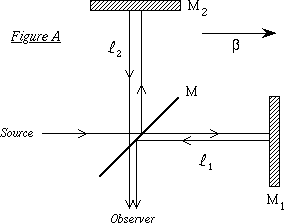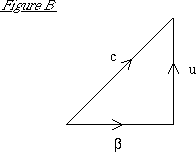 |
 |
INTRODUCTION
For the purpose of this experiment, assume that there exists an ether that permeates all space and is at rest, and that light travels with a speed of c in that ether. The ether is fixed in space, so if we travel with some speed through the ether, then the speed of light we measure would be given by the Galilean velocity transformation,
V' = C ± β
depending upon whether we are moving in the same direction as the light wave, or opposite to it.
If light is a wave in the ether, then we can characterize a light beam by its period T, the time for a wave to complete one cycle. The period is simply the inverse of the wave's frequency: T = f –1
The Michelson interferometer (Figure A) was designed to test this assumption. It splits a beam of light into two beams by a partially reflecting surface, M; the two beams travel along perpendicular paths and are then reunited to form an interference pattern; this pattern is sensitive to any differences in the speeds of the light traveling along the two paths.
 |
 |
We can find the difference in the time of travel for the two beams of light in the following way: assume path 1,  1, is exactly parallel to the earth's velocity β. In this case the light travels from M to M1 with speed c + β (relative to the interferometer) and back from M1 to M with speed c – β. Thus the total time for the round trip on path 1 is:
1, is exactly parallel to the earth's velocity β. In this case the light travels from M to M1 with speed c + β (relative to the interferometer) and back from M1 to M with speed c – β. Thus the total time for the round trip on path 1 is:

The speed of light traveling from M to M2 is given by the velocity-addition diagram in Figure B. That is, relative to the earth, the light has velocity u perpendicular to β; relative to the ether it travels with speed c in the direction shown. This speed is
Since the speed is the same on the return journey, the total time for the round trip on path 2,  2, is
2, is

Comparing t1 and t2 we see that the waves traveling along the two paths take slightly different times to return to M (which takes longer?). After some mathematical manipulation, the time difference, Δt is found to be:
 |
If this difference Δt were zero, the two waves would arrive in step and interfere constructively, giving a bright resultant signal. Similarly, if Δt were equal to half a period of the light wave, the two waves would be exactly out of step and would interfere destructively. We can express the number of complete cycles by which the two waves arrive out of step in the following way:

If we were to then rotate the interferometer 90o, as Michelson did, this difference should double from one position to the next:
 |
Michelson believed that it should be possible to detect a shift of this much with his interferometer, allowing him to show that light travels at different speeds in different directions.
EXPERIMENT
REPORT
|
|
||
| © | St. Lawrence University | Department of Physics |
| Revised: 16 May 2017 | Canton, NY 13617 |